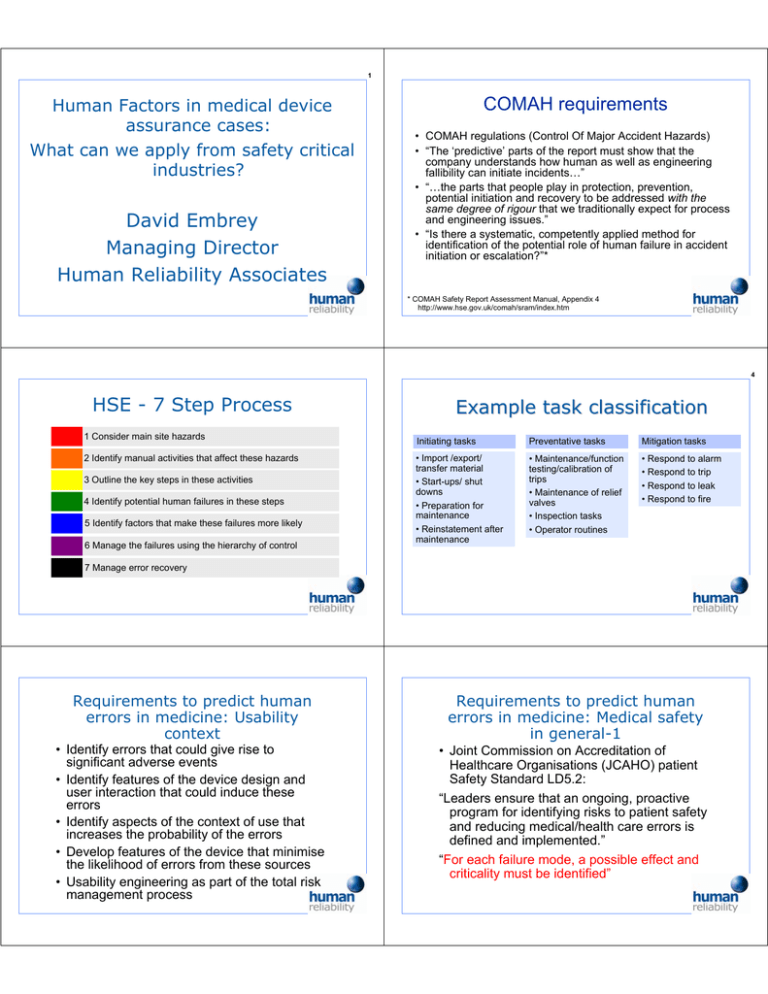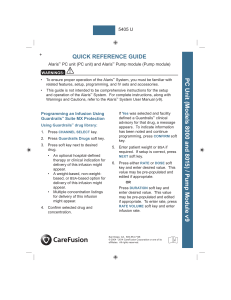COMAH requirements Human Factors in medical device assurance cases:
advertisement

1 Human Factors in medical device assurance cases: What can we apply from safety critical industries? David Embrey Managing Director Human Reliability Associates COMAH requirements • COMAH regulations (Control Of Major Accident Hazards) • “The ‘predictive’ parts of the report must show that the company understands how human as well as engineering fallibility can initiate incidents…” • “…the parts that people play in protection, prevention, potential initiation and recovery to be addressed with the same degree of rigour that we traditionally expect for process and engineering issues.” • “Is there a systematic, competently applied method for identification of the potential role of human failure in accident initiation or escalation?”* * COMAH Safety Report Assessment Manual, Appendix 4 http://www.hse.gov.uk/comah/sram/index.htm 4 HSE - 7 Step Process 1 Consider main site hazards 2 Identify manual activities that affect these hazards 3 Outline the key steps in these activities 4 Identify potential human failures in these steps 5 Identify factors that make these failures more likely 6 Manage the failures using the hierarchy of control Example task classification Initiating tasks Preventative tasks Mitigation tasks • Import /export/ transfer material • Start-ups/ shut downs • Preparation for maintenance • Reinstatement after maintenance • Maintenance/function testing/calibration of trips • Maintenance of relief valves • Inspection tasks • Operator routines • Respond to alarm • Respond to trip • Respond to leak • Respond to fire 7 Manage error recovery Requirements to predict human errors in medicine: Usability context Requirements to predict human errors in medicine: Medical safety in general-1 • Identify errors that could give rise to significant adverse events • Identify features of the device design and user interaction that could induce these errors • Identify aspects of the context of use that increases the probability of the errors • Develop features of the device that minimise the likelihood of errors from these sources • Usability engineering as part of the total risk management process • Joint Commission on Accreditation of Healthcare Organisations (JCAHO) patient Safety Standard LD5.2: “Leaders ensure that an ongoing, proactive program for identifying risks to patient safety and reducing medical/health care errors is defined and implemented.” “For each failure mode, a possible effect and criticality must be identified” Task Error Assessment Method (TEAM) 7 Develop Criticality Index to prioritise areas of intervention Task Consequences X criticality Consequences Exposure Likelihood of error Recovery Error Prob. Exposure X Lack of Recovery X Risk ranking = score A 3 2 2 3 36 B 2 3 3 1 18 C 2 1 2 3 12 D 1 2 3 1 6 task analysis Error prediction Planning Errors Error reduction Action Errors Checking Errors Retrieval Errors Information / Communication Errors Selection Errors 0 Safely use infusion pump 1 Prepare patient 3 Program pump 5 Start pump 2 Prepare infusion pump Plan 0: Do 1-5 in order; do 6 every hour; do 7-8 as required; do 9 at end of treatment 7 Remove giving set/ change solution 2.1 Check leads 9 Stop infusion 2.2 Check administratio n set (s) 2.3 Check pump batter (ies) Plan 2: Do 1-3 in any order; do 4-5 in order 2.4 Prime giving set 2.5 Prepare pump Plan 2.4: Do in order 2 Prepare infusion pump 4 Connect patient 6 Check infusion progress 8 Respond to alarm 2.4.1 Open Roller Clamp 2.4.2 Spike Bag See next slide 2.4.3 Partially fill drip chamber 2.4.4 Invert plastic bubble 2.4.5 Expel air from infusion set 2.4.6 Close roller clamp 11 Examples of PHEA Error Types TEAM Stage 4: Identify significant errors using Predictive Human Error Analysis (PHEA) PHEA Planning Errors Action Errors Checking Errors Retrieval Errors Information / Communication Errors Selection Errors • Uses a standardised set of possible human failure modes as guide words to assist error identification process • Actions, communications & checks considered • Could be extended to consider cognitive errors (e.g. misdiagnosis) Action Checking Information Retrieval Information Communication Errors (Person to person) Selection (between two alternative objects) Right action, wrong object Check omitted Information not obtained Information not communicated Selection omitted Action omitted Check incomplete Wrong information obtained Wrong information communicated Wrong selection made Action too late/early Information retrieval incomplete Information communication incomplete in wrong direction Information incorrectly interpreted Information communication unclear Predictive Human Error Analysis -1 Predictive Human Error Analysis -2 Task Step Error Type Description Consequences Recovery Error causes/preventi on Task Step Error Type Description 2.1 Check leads C1: Check Omitted Operator fails to check lead connections Possible loss of power to pump due to equipment failure Supervisor /colleague checks T1: Checklist C1: Training: identify risks D1: Make connections self indicating 2.4.1 Open Roller Clamp Action omitted Action insufficient Roller clamp remains closed 2.2 Check administration set(s) C1: Check Omitted Operator fails to check integrity of administration set Possible contamination of solution/pump Supervisor /colleague checks T1: Checklist C1: Training: identify risks 2.4.2 Spike Bag Action too much Bag spiked excessively 2.3 Check pump battery (ies) C1: Check Omitted Operator fails to check condition of one or more batteries Possible loss of power due to failure to maintain battery Supervisor /colleague checks C1: Ensure fresh batteries readily available D1 Make battery condition self indicating 2.4.3 Partially fill drip chamber Action too much Action omitted Drip chamber overfilled Mapping Performance Influencing Factors (PIFs) on to PHEA error modes Action errors Checking errors Device design • • • • • Controls Displays Labelling Access Anthropometric s Step 2.5 Reset Infusion rate at end of procedure Error type: Action too much Communication errors (person to person) Info retrieval errors Context • Frequency of change • Similarity to other tasks • Isolated actions • Complexity • Frequency Infusion rate set too high • Distractions • Roles & responsibilities • Perceived risks • Fatigue • Morale Recovery Likelihood: Low Recovery Error causes /prevention Task cannot proceed N/A Possible contamination of solution/pump from egress of fluid Supervisor or colleague checks Checklist Training point Flow ineffective Supervisor or colleague checks Checklist Training point Addressing identified errors Selection errors Task features Consequences Consequences: Possible fatality Decision table for interventions PIF Proposed solution Cost Imported risks? Decision D1 Quality of device controls & displays D1: Enhance visibility of range markings Low Need to consider population stereotypes Y D2: Increase pointer contrast Medium T1 Degree of feedback (Low) T1: Introduce infusion rate as a checklist item Low Y C1:Roles & responsibility ( No assignment of responsibility) C1: Redesign task with clear assignments of responsibility Low Y C2: Distracting environment C2: Ensure no multitasking at critical phase of infusion Medium Y • Identify which factors have an impact on that type of error • Evaluate these factors in the specific context of use (e.g. ward, A & E room, pharmacy, blood transfusion) • Repeat for other errors identified in the analysis • Decide on intervention strategy (may affect likelihood of a number of types of error) Conclusions • Usability cannot be considered in isolation from the nature of the task, and the context of use • Tools such as TEAM originally developed in safety critical industries provide a systematic framework for identifying potential errors • Benefits arise from using a task orientated analysis together with an error mode identification process • Interventions to manage identified failure modes can be documented as part of the Assurance Case



